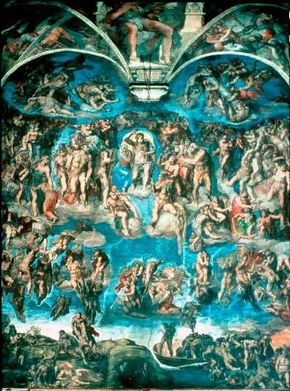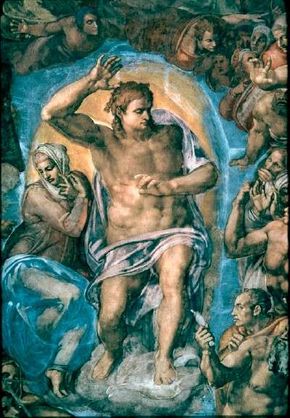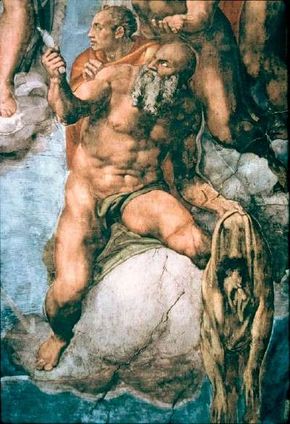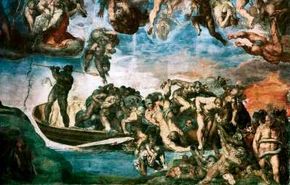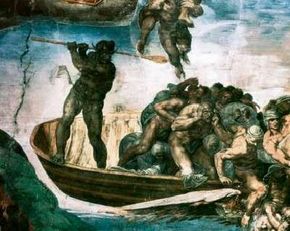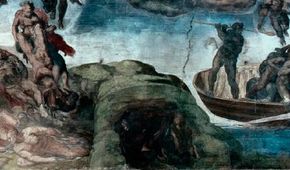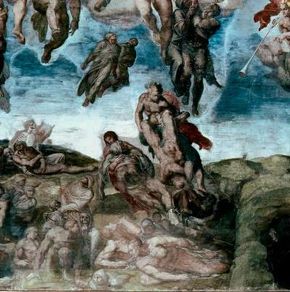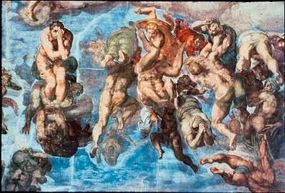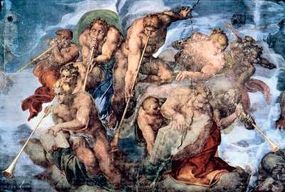Michelangelo created no paintings between the completion of the Sistine Chapel ceiling in 1512 and the beginning of his painting Last Judgment in 1536. Commissioned by Pope Paul III, Last Judgment (1536-41) marked a change in style for the artist. His palette grew more monochromatic, and the proportions of his figures grew broader and more menacing. The piece, seething with nudity and brutality, was criticized because the massive and contorted figures, which were placed behind the altar of the Chapel, were shockingly naked and thus thought indecent.
Advertisement
An older and more thoughtful Michelangelo originally accepted the commission for this important painting from Pope Clement VII. The original subject of the mural was the resurrection, but with the Pope's death, his successor, Pope Paul III, felt the Last Judgment was a more fitting subject for 1530s Rome and the judgmental impulses of the Counter-Reformation.
While traditional medieval last judgments showed figures dressed according to their social positions, Michelangelo created a new standard. His groundbreaking concept of the event shows figures equalized in their nudity, stripped bare of rank. The artist portrayed the separation of the blessed and the damned by showing the saved ascending on the left and the damned descending on the right. The fresco is more monochromatic than the ceiling frescoes and is dominated by the tones of flesh and sky. The cleaning and restoration of the fresco, however, revealed a greater chromatic range than previously apparent. Orange, green, yellow, and blue are scattered throughout, animating and unifying the complex scene.
Follow the links below to see and learn about some of the most striking and important scenes from this powerful work, Michelangelo's Last Judgment.
- Christ Within the Last Judgment: Michelangelo's Christ in the Last Judgment is broad and powerful. Read more about the central figure in this masterpiece.
- St. Bartholomew Within the Last Judgment: Learn why Michelangelo chose St. Bartholomew's scene for his own self portrait.
- Minos Within the Last Judgment: Michelangelo showed Minos, the king of Hell, with the unmistakable likeness of his own most despised enemy. Find out more about this scene from Hell's innermost circle.
- Charon Within the Last Judgment: Michelangelo borrowed from Dante when he included Charon as the ferryman over the River Styx. Read more about the connection to Dante's Inferno.
- Hell's Mouth Within the Last Judgment: Michelangelo chose the space above the altar for Hell's Mouth. Perhaps he wanted to remind the ecclesiastics of their own peril on judgment day. See this harrowing image of Hell.
- More Painting Details Within the Last Judgment: While much of the fresco focuses on the torments of Hell, there is also beauty and angels. Go to the last page to see Michelangelo's angels in three different details.
On the next page, see Christ as Michelangelo chose to show him on the last day.
To learn more about Michelangelo, art history, and other famous artists, see:
Advertisement
